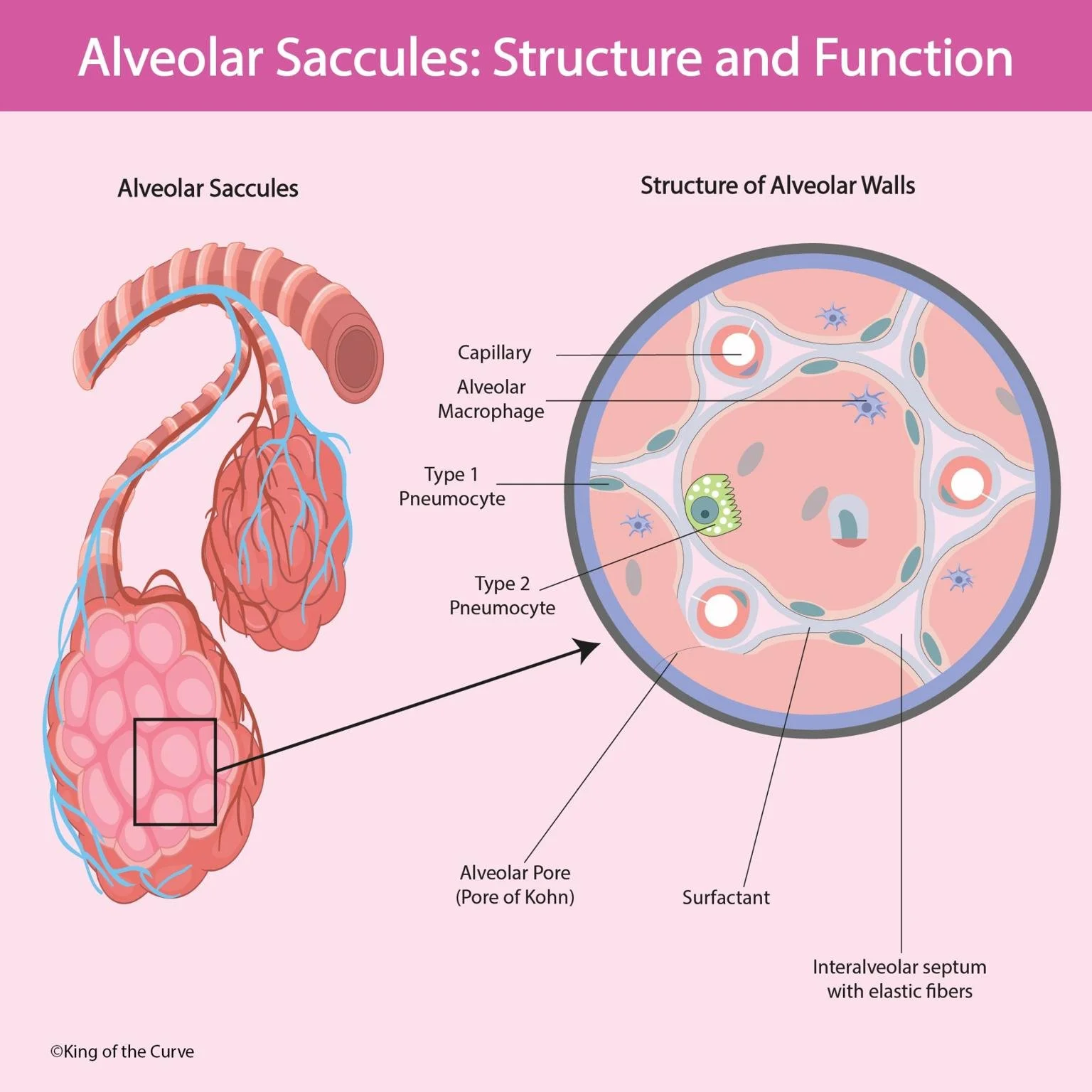🌬️ Alveolar Saccules: The Microscopic Air Sacs That Power Your Lungs – MCAT Edition
Take a deep breath. That simple act sets off a cascade of microscopic processes, all beginning in the alveolar saccules—tiny structures responsible for the exchange of gases that keep you alive.
On the MCAT, alveolar structure and function is a high-yield physiology topic, often disguised within passages on respiration, surfactant, or lung disease. In this blog, we’ll use a King of the Curve exclusive visual to make this complex structure stick in your brain for test day.
🧪 Why Alveoli Matter on the MCAT
Alveolar structure integrates with multiple MCAT content areas:
MCAT Section: Biological and Biochemical Foundations of Living Systems
AAMC Category 3B: Structure and integrative functions of the main organ systems
Common Test Themes:
Gas exchange and diffusion
Role of surfactant in newborns
Lung compliance and elastic recoil
Immune function in alveoli (e.g., macrophages)
🧠 Quick Win: Recognizing how Type I and Type II pneumocytes function is a recall-based question the MCAT loves to slip in.
🔍 Key Structures to Know
🫁 Type I Pneumocyte
Thin, flat epithelial cells covering ~95% of alveolar surface.
Function: Gas exchange between air and capillaries.
MCAT Relevance: Increased diffusion efficiency due to thin walls.
🫧 Type II Pneumocyte
Cuboidal cells scattered among Type I.
Function: Secrete surfactant, reduce surface tension, and regenerate Type I cells.
Clinical Link: Deficiency → neonatal respiratory distress syndrome.
💨 Surfactant
Lipoprotein complex secreted by Type II cells.
Function: Prevents alveolar collapse during exhalation.
MCAT Tip: Appears in developmental bio + physiology passages.
🧼 Alveolar Macrophage
Immune cells that patrol the alveoli.
Function: Remove pathogens and particulates.
MCAT Angle: Link to innate immunity + pulmonary clearance.
🔁 Alveolar Pores (Pores of Kohn)
Openings between alveoli for collateral ventilation.
Important during partial obstruction of airflow.
🩸 Capillaries + Elastic Fibers
Capillaries wrap tightly around alveoli for oxygen/CO₂ exchange.
Elastic fibers allow recoil and passive exhalation.
🧠 MCAT Question Clues & Practice Tips
“Premature infant with labored breathing…” → Surfactant
“Thin-walled squamous epithelial cell…” → Type I pneumocyte
“Alveolar immune defense…” → Macrophage
“Elastic recoil of lungs is reduced…” → Loss of interalveolar septa (e.g., emphysema)
📣 Call to Action
Ready to crush MCAT respiratory physiology?
🎁 Access this visual and over 1000+ others to simplify your science prep:
➡️ https://mcat.kingofthecurve.org
Stay sharp with free daily questions:
➡️ https://kingofthecurve.org/qotd
Explore our pre-med prep essentials:
➡️ https://kingofthecurve.org/pre-med-essentials
Frequently Asked Questions (FAQs)
-
Aim for 4-6 focused hours, ensuring you incorporate breaks to avoid burnout.
-
Practice mindfulness techniques, take practice exams under realistic conditions, and maintain a balanced lifestyle.
-
Set short-term goals, seek support from mentors, and reward yourself for small achievements.
-
Regular exercise improves focus, reduces stress, and enhances overall mental clarity.
-
KOTC offers personalized learning tools, gamification features, and adaptive question banks to help students stay on track without burnout.


